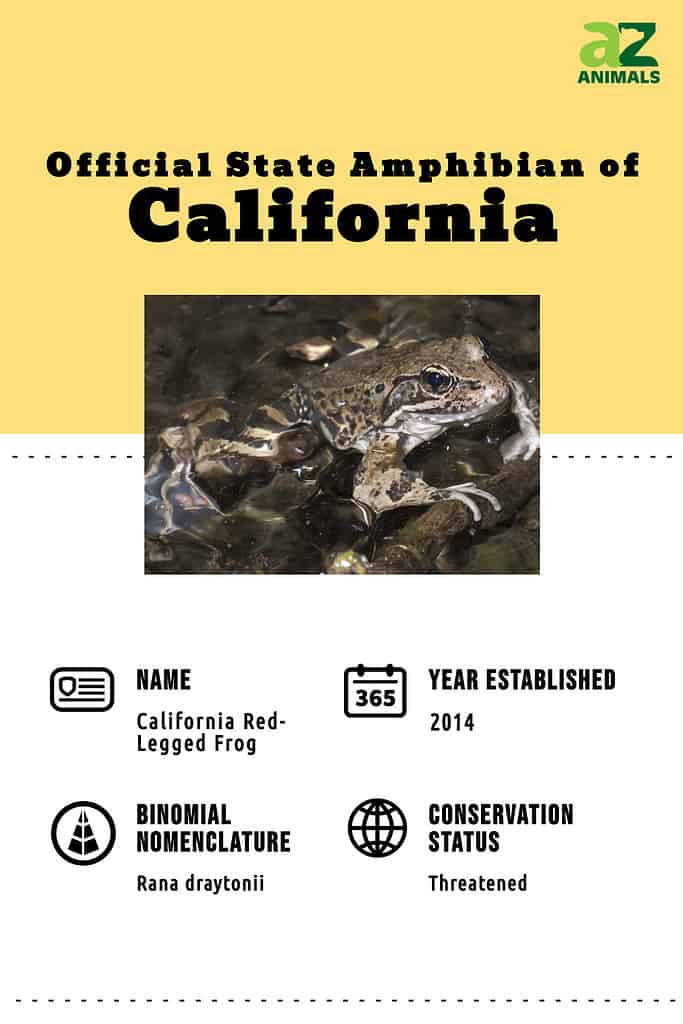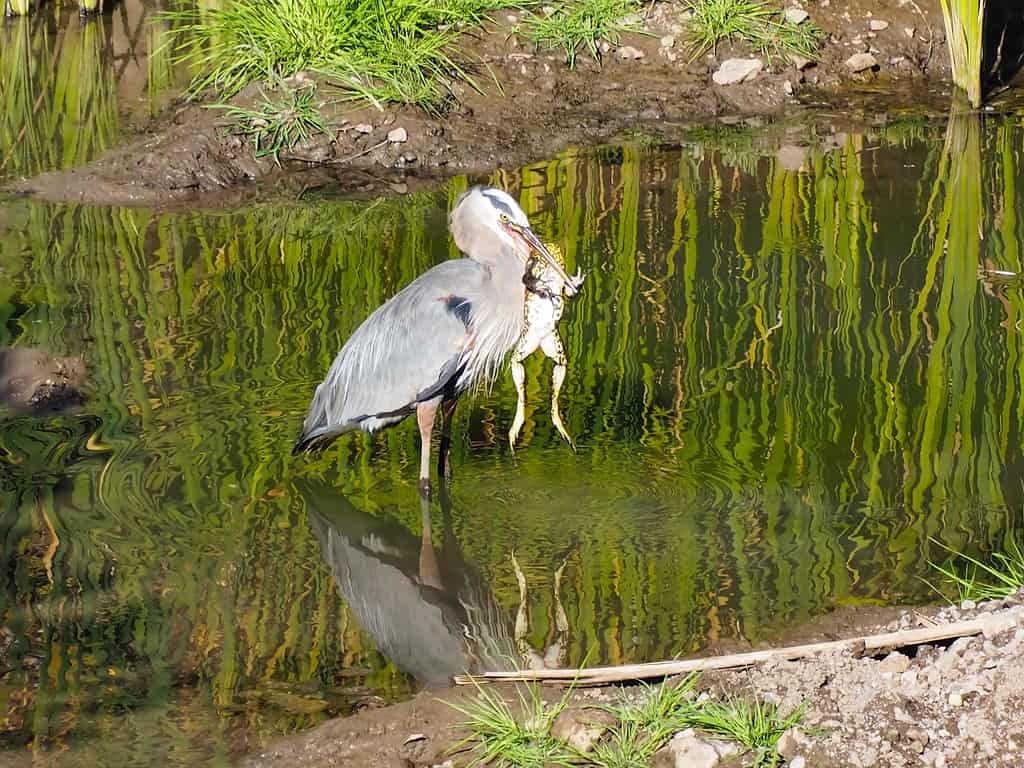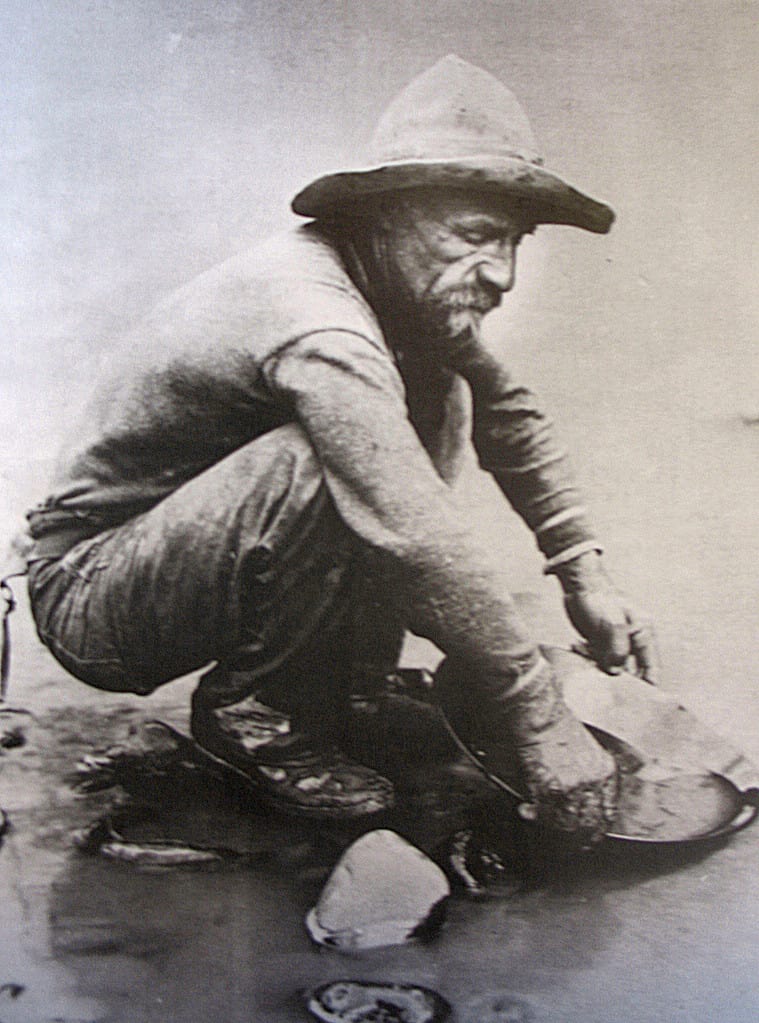The California red-legged frog (Rana draytonii) became the official state amphibian of California when Governor Jerry Brown signed Assembly Bill 2364 on June 28, 2014.

California Red-Legged Frog
The California red-legged frog is a true California amphibian that doesn’t live anywhere else. It has a rich and interesting history that ties directly to the history and culture of California. This frog, however, also faces an uncertain future.
Appearance and Size
The California red-legged frog is named for its abdomen and hind legs, which are often red or salmon pink. The frog’s back can vary in color. Red-legged frogs can be olive green, brown, gray, or reddish-brown in color. The frog features black specks and dark, irregular blotches of color on its back, as well. The amphibian’s underside is typically light gray in the front. That gray transitions to the red hindquarters.
The California red-legged frog is the largest native frog species in the western United States. Adult females can grow up to five and a half inches long. Males are smaller, measuring about an inch shorter than females at maturity.
Habitat
The California red-legged frog lives in or near slow-moving or standing water, such as ponds and streams. It relies on aquatic vegetation such as cattails and grasses to protect it both from predators and the California sun. The frog cannot tolerate excessive heat and can even enter a dormant state during heat waves.

You can see the California red-legged frog in or near the water.
©iStock.com/yhelfman
Prey
Since they are sensitive to heat and sunlight, California red-legged frogs are largely crepuscular and nocturnal predators. These frogs prey on insects and invertebrates, but their large size also allows them to predate smaller frogs, fish, and small mammals such as mice.
Predators
California red-legged frogs are an important food source for many predators. Newts eat red-legged frog eggs. Crayfish prey on eggs and tadpoles.
Mature red-legged frogs are prey for largemouth bass, snakes, foxes, raccoons, coyotes, egrets, and herons. These frogs also face predation by invasive species.

Apparently, this heron in California ordered a frog for lunch.
©iStock.com/jodiofca
Distribution
The name of the California red-legged frog highlights its original habitat exclusively in California, U.S., though it also stretches to the northernmost parts of Baja California, Mexico. However, the frog now occupies just a fraction of its former territory.
In the past, people spotted this frog in 46 California counties, ranging from southern Mendocino County, California, inland to Shasta County, California, and continuing south to Baja California, Mexico. But today, 70% of its original habitats in California and Mexico no longer have this frog. Most of these frogs now reside in the coastal drainages of central California, spanning from Marin County to northern Baja California, Mexico.
This video from the Santa Barbara Zoo gives an up-close look at California’s state amphibians.
State Recognition
The move to designate the California red-legged frog as the official state amphibian was proposed by teacher Virginia Haddad and some of her Sea View Elementary School students. These schoolchildren met together in an after-school club known as the “Prodigy Cats.” The group researched possibilities for the state amphibian and decided the California red-legged frog was the best candidate for official recognition. They wrote to California Assemblyman V. Manuel Pérez (D) to propose the idea.
Pérez then visited the school, holding an assembly to teach students about the legislative process. The entire school and much of the larger community got behind the effort.
Pérez introduced the bill in the California legislature. Two students from Sea View Elementary, Samantha Lambarena (11) and Freedom Payne (12), flew to Sacramento along with Haddad, the school’s principal, Timothy Steele, and the district superintendent, Darryl Adams. The students spoke to legislators, advocating for the designation of the California red-legged frog as the state’s official amphibian. They highlighted how the frog is unique to California and also how it benefits humans by eating insects that can carry diseases. Their efforts were rewarded when the bill was passed and then signed into law two months later.
A Famous Frog
The California red-legged frog became known across the United States through a short story by Mark Twain. “The Celebrated Jumping Frog of Calaveras County” was first published in The Saturday Press, a New York literary periodical, in 1865. The story was Twain’s first work to receive national acclaim, but the author wasn’t the only one made famous through the story. The entire nation now knew of the California red-legged frog which featured in the tale.
Angel’s Camp, the only incorporated city in Calaveras County, California, still celebrates the notoriety it gained from the Twain story. There is an annual Frog Jumping Jubilee held each year in this self-proclaimed “Frogtown, USA.” However, red-legged frogs are not used in these festivities due to their state and federal-protected status.

Samuel Langhorne Clemens, a.k.a. Mark Twain, created a short story about the California red-legged frog.
©Abdullah frères / Public domain – License
The California Gold Rush
While the nation learned of the California red-legged frog in Twain’s 1865 story, miners in California’s gold rush already knew all about the amphibian, mainly because they ate it. The gold rush began in 1849, and many of the “miner forty-niners” who flooded the state were big on dreams but short on food. The California red-legged frog was so numerous that it became a dietary staple for miners who consumed nearly 80,000 of the frogs per year during the gold rush.

California’s gold rush brought gold seekers such as this man in 1850, many of whom found the California red-legged frog to be an easy and readily available meal.
©Photo: L. C. McClure / Public domain – License
Modern Threats
The California red-legged frog is no longer finding its way onto the dinner table of hungry miners, but the amphibian is still under serious threat. The introduction of non-native fish, along with the invasive American bullfrog, has had a deleterious impact on the California red-legged frog population. These fish and bullfrogs predate California red-legged frog eggs and tadpoles, as well as mature frogs.
The severe drought in California has put unsustainable pressure on the state’s water resources. Many ponds, pools, and streams where these frogs live receded to dangerously low water levels. Smaller ponds and reservoirs completely dried up during the historic drought.
Along with habitat loss due to drought, more than 90% of historic wetlands in the Central Valley of California have been diked, drained, or filled, according to U.S. Fish and Wildlife Service (FWS). These measures have allowed for agricultural development and urban development. The widespread use of biocides and fertilizers, as well as the spread of pathogens, also present serious threats to California’s state amphibians.
Conservation Status
In 1996, the FWS listed the California red-legged frog as a threatened species, and California also recognized it as a species of special concern during that year.
U.S. and Mexican wildlife agencies are now partnering for conservation and reintroduction efforts. They have transported red-legged frog eggs from Baja California, Mexico, to safeguarded regions in California.
Red-legged frogs have also been released in Yosemite National Park after disappearing from the park around 50 years ago, as seen in this video created by The Fresno Bee.
The future of the California red-legged frog is far from certain, but all of these initiatives to protect and reintroduce the frog give at least some reason for optimism. We can all look forward to the day when the frog will once again proliferate the ponds, marshes, and streams of California and northern Baja California.
The photo featured at the top of this post is © Wirestock Creators/Shutterstock.com
Thank you for reading! Have some feedback for us? Contact the AZ Animals editorial team.






